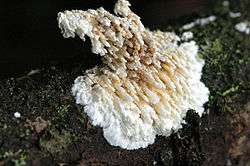Hymenochaetales
| Hymenochaetales | |
|---|---|
| | |
| Inonotus tamaricis | |
| Scientific classification | |
| Kingdom: | Fungi |
| Division: | Basidiomycota |
| Class: | Agaricomycetes |
| Order: | Hymenochaetales Oberw. (1977) |
| Families | |
|
Hymenochaetaceae Imazeki & Toki | |
The Hymenochaetales are an order of fungi in the class Agaricomycetes. The order in its current sense is based on molecular research and not on any unifying morphological characteristics. According to one 2008 estimate, the Hymenochaetales contain around 600 species worldwide,[1] mostly corticioid fungi and poroid fungi, but also including several clavarioid fungi and agarics. Species of economic importance include wood decay fungi in the genera Phellinus and Inonotus sensu lato, some of which may cause losses in forestry. Therapeutic properties are claimed for Inonotus obliquus ("chaga") and Phellinus linteus, both of which are now commercially marketed.
Taxonomy
History
The order was proposed in 1977 to recognize the family Hymenochaetaceae at a higher taxonomic rank. As originally conceived, species within the Hymenochaetales had several morphological features in common, notably brown or brownish basidiocarps (fruit bodies) that turn black in alkali, hyphae lacking clamp connections, and the presence (in most species) of characteristic setae (thick-walled, thorn-shaped cystidia, visible under a hand lens).[2]
Subsequent ultrastructure research showed that the Hymenochaetales had dolipores with imperforate parenthesomes, whereas most Agaricomycetes have dolipores with perforate parenthesomes.[3][4] Species of the corticioid genera Hyphodontia and Schizopora were later found to share this peculiarity,[5] suggesting they might also be related to the Hymenochaetales, though morphologically dissimilar.
Current status
Molecular research, based on cladistic analysis of DNA sequences, has substantially expanded and redefined the Hymenochaetales, dividing the order into at least six different clades.[2] The core clade represents the traditional Hymenochaetaceae, excluding the genera Coltricia and Coltriciella; another clade includes the corticioid genera Lyomyces and Schizopora (Schizoporaceae), together with Coltricia and Coltriciella as a subclade; a further clade (Repetobasidiaceae) includes agaricoid Rickenella species,[6] the clavarioid Alloclavaria purpurea,[7] and various corticioid fungi, including the genus Repetobasidium; the three remaining clades consist of corticioid Hyphodontia species, corticioid Kneifiella species, and poroid Oxyporus species.[2]
Not all the species currently placed within the Hymenochaetales have dolipores with imperforate parenthosomes, so the order lacks any shared morphological characteristics.[2]


Rickenella swartzii (Repetobasidiaceae) 
Schizopora paradoxa (Schizoporaceae) Coltricia perennis
(Coltricia subclade)
Hyphodontia arguta (Hyphodontia clade)
Habitat and distribution
Most fungi within the order are saprotrophs of dead wood, but some species within the Hymenochaetaceae can cause rots of living trees. Species of Coltricia and Coltriciella are ectomycorrhizal.[8] Agaricoid species of Rickenella and related genera are parasites of mosses and liverworts.[6] Distribution of the Hymenochaetales is cosmopolitan.
Economic importance
Several wood decay fungi in the genera Phellinus and Inonotus sensu lato are pathogenic, causing losses in forestry plantations. Therapeutic properties are claimed for Inonotus obliquus ("chaga")[9] and Phellinus linteus,[10] both of which are commercially marketed as alternative medicines.
Genera incertae sedis
Several genera in the Hymenochatales are incertae sedis with respect to familial placement:
- Atheloderma Parmasto (1968)
- Caeruleomyces Stalpers (2000)[11]
- Cyanotrama Ghob.-Nejh. & Y.C. Dai (2010)[12]
- Fibricium J.Erikss. (1958)
- Ginnsia Sheng H.Wu & Hallenb. (2010)[13]
- Lawrynomyces Karasiński (2013)[14]
- Physodontia Ryvarden & H.Solheim (1977)
- Subulicium Hjortstam & Ryvarden (1979)
References
- ↑ Kirk PM, Cannon PF, Minter DW, Stalpers JA (2008). Dictionary of the Fungi (10th ed.). Wallingford, UK: CAB International. p. 116. ISBN 978-0-85199-826-8.
- 1 2 3 4 Larsson K-H; et al. (2006). "Hymenochaetales: a molecular phylogeny for the hymenochaetoid clade". Mycologia. 98: 926–936. doi:10.3852/mycologia.98.6.926. PMID 17486969.
- ↑ Moore RT. (1980). "Taxonomic significance of septal ultrastructure in the genus Onnia". Bot. not. 133: 169–175.
- ↑ Müller WH, et al. (2000). "The taxonomic position of Asterodon, Asterostroma and Coltricia inferred from the septal pore cap ultrastructure". Mycological Research. 104: 1485–1492. doi:10.1017/s0953756200002677.
- ↑ Langer E, Oberwinkler F (1993). "Corticioid Basidiomycetes I. Morphology and ultrastructure". Windahlia. 20: 1–28.
- 1 2 Redhead SA, Moncalvo J-M, Vilgalys R, Lutzoni F (2002). "Phylogeny of agarics: partial systematics solutions for bryophilous omphalinoid agarics outside of the Agaricales". Mycotaxon. 82: 151–168.
- ↑ Dentinger BTM, McLaughlin DJ (2006). "Reconstructing the Clavariaceae using nuclear large subunit rDNA sequences and a new genus segregated from Clavaria". Mycologia. 98: 746–762. doi:10.3852/mycologia.98.5.746. PMID 17256578.
- ↑ Tedersoo L, Suvi T, Beaver K, Saar I (2007). "Ectomycorrhizas of Coltricia and Coltriciella (Hymenochaetales, Basidiomycota) on Caesalpiniaceae, Dipterocarpaceae and Myrtaceae in Seychelles". Mycological Progress. 6: 101–107. doi:10.1007/s11557-007-0530-4.
- ↑ Mizuno T. (1999). "Antitumor and hypoglycemic activities of polysaccharides from the sclerotia and mycelia of Inonotus obliquus". International Journal of Medicinal Mushrooms. 1 (1): 301–316. doi:10.1615/intjmedmushr.v1.i4.20.
- ↑ Zhu T, Kim SH, Chen CY (2008). "A medicinal mushroom: Phellinus linteus". Current Medicinal Chemistry. 15 (13): 1330–5. doi:10.2174/092986708784534929. PMID 18537612.
- ↑ Stalpers JA. (2000). "The genus Ptychogaster" (PDF). Karstenia. 40: 167–80.
- ↑ Ghobad-Nejhad M, Dai YC (2010). "Diplomitoporus rimosus is found in Asia and belongs to the Hymenochaetales". Mycologia. 102 (6): 1510–7. doi:10.3852/10-025. PMID 20943544.
- ↑ Wu SH, Nilsson RH, Chen CT, Yu SY, Hallenberg N (2010). "The white-rotting genus Phanerochaete is polyphyletic and distributed throughout the phleboid clade of the Polyporales (Basidiomycota)". Fungal Diversity. 42: 107–18. doi:10.1007/s13225-010-0031-7.
- ↑ Karasiński D. (2013). "Lawrynomyces, a new genus of corticioid fungi in the Hymenochaetales". Acta Mycologica (Warszawa). 48 (1): 5–11. doi:10.5586/am.2013.001.